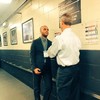Photo by Warren Toda - European Pressphoto Agency
By way of his basketball stature and general aesthetic, it’s been a rough year for John Wall. As his career stutter-steps through persistent health issues and condemning realizations about his leadership style, with a super-max contract extension (he can make over $46 million in 2023 alone, if he wants) set to kick in next year, Wall is besieged by more uncertainty than someone with his talent and resume should be.He’s still very good, with the promise to be great, and every criticism pointed in his direction distracts from a man who, having just turned 28, has made five straight All-Star teams. But looking at his impact purely through a basketball-centric context relative to the best players at his position, it’s hard to say if Wall is improving, declining, or stuck in neutral as he wades into his ninth NBA season.The questions have always centered around his shaky jump shot, willingness to operate off the ball, and defensive indifference. Those blemishes have come to define him as much as, if not more than the springboard athleticism, blinding speed, uncanny vision, and indisputable toughness that convinced the Washington Wizards to lock him down at the costly price they did. As they fold new faces like Dwight Howard and Austin Rivers into the mix, their short and long-term future ultimately hinges on a race between Wall's good and bad. Which traits can improve before others start to deteriorate? It may ultimately mean nothing, but according to metrics that have tracked Wall's average speed and distance over the past few years, his trademark advantage may be eroding. In a league ultimately decided by split-seconds and quarter-inches, what if he’s already slowing down?Out of 539 players listed on NBA.com as having logged at least one minute last season, Wall ranked 532nd in average offensive and defensive speed, and 531st in average overall speed. Dirk Nowitzki, DeMarcus Cousins, and James Harden were the only rotation players slower in the latter category, which means Wall clocked in below—among many, many others—Marc Gasol, Zach Randolph, and Greg Monroe. He placed near the bottom in 2017, too, continuing a steady decline from the 2013-14 season (the earliest this data is available, and also his first All-Star season), but last year’s drop—mid-season surgery aside—shouldn't be ignored.Let’s focus on his average offensive speed, which was 3.83 miles per hour in 41 games. (And 3.80 before he had surgery in late January.) During the 2016-17 season, Wall's average offensive speed was 4.07 miles per hour. In 2015-16, it was 4.43. In 2014-15, it was 4.39. And in 2013-14, it was 4.48. There are myriad reasons why any player’s average speed might fluctuate from year to year—injuries, surrounding personnel, and playing style, to name a few—and the data provided by NBA.com doesn’t nearly go deep enough to form any conclusion either way.But for someone who harnesses this edge to buff out the aforementioned smudges in his game; who isn’t built to dominate the same way without unleashing his greatest strength as often as he once did—Wall may already be on an alarming track.Speed is hardly the determinant when it comes to any high-usage player’s ultimate impact. In the same way LeBron James and James Harden are tracked as two of the slowest players in the league, both are still able to accelerate and explode in ways that make their opponents cower. They’re also heavier, stronger, and more powerful than Wall.It may not be entirely related, but Wall was also less effective scoring in the open floor last season. Movement through tight spaces is hard to quantify, but as the ball-handler in transition, Wall’s field goal percentage dropped to 46.2, per Synergy Sports. In the five years prior, he never finished below 50 percent. (The Wizards have always tilted towards transition at a league-high rate with Wall on the floor, including last season, per Cleaning the Glass.)Again, there are reasons for that decline that are more than likely related to his ailing knee. Wall settled for pull-ups and strange step-backs against retreating defenses that made a point to hustle back and protect the paint. Opportunities to downhill ski towards the rim weren’t extinct, but watch the film and they’re relatively few and far between.It’s hard to watch plays like this and not immediately think about the mental hurdles Wall had to vault after January’s knee operation. Normally terrific around the rim—steering his chiseled 6’4” frame into the lane at will—possessions that were once capped by a thunderous finish or breathtaking artistry fizzled instead. Simple bunnies would chime off the back iron or smash off the glass and miss everything altogether. It's hard not to look at someone of Wall's pedigree, finishing plays like this, and not feel like you were watching a player who didn’t trust his legs, forever the most important tools he has. They either flew too fast or a beat too slow; a shade out of sync with his internal ETA.It’s here where Wall’s knee operation matters. Here’s what a longtime physical therapist told the Washington Post after Wall’s procedure: “You can come back and play within six to eight weeks but there’s no way you can be 100 percent in six to eight weeks because you’re not at 100 percent going into surgery. You can be back to the level you were going into surgery, maybe a little better, but it’s going to be until the offseason when you can get some down time before you can truly be 100 percent.”The summer months should’ve done his body well, conceivably enough for Wall to reverse course and find ways to showcase his speed as frequently and effectively as he once did. He's a damn fine player regardless, but if he's still able to break the sound barrier, the Wizards may finally be prepared to punch through to the other side.
Advertisement
Advertisement
Advertisement
